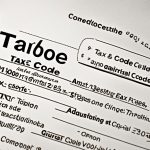Last Updated on: 2nd December 2024, 09:17 am
Are you curious about how tax codes like 1383M impact your earnings and financial planning in the UK? Understanding your tax code is essential for ensuring you pay the correct amount of tax while maximizing your benefits.
The 1383M tax code, specifically designed for those utilizing the Marriage Allowance, is a great way for couples to optimize their household income.
But how does it work, and who qualifies? In this guide, we’ll break down everything you need to know about the 1383M tax code, including eligibility, calculations, common issues, and how to maximize its advantages.
Let’s dive into the details to demystify this important aspect of UK taxation.
What Is the 1383M Tax Code and How Does It Work?

The 1383M tax code is assigned to individuals who have benefited from the Marriage Allowance. It is specifically designed to increase the tax-free income of the higher-earning spouse or civil partner.
The numerical part, 1383, represents the individual’s tax-free income allowance divided by 10, while the letter M indicates that the individual has received a transfer of unused allowance from their partner.
For the financial year 2024-2025, the standard Personal Allowance is £12,570, the amount you can earn before paying income tax.
Under the Marriage Allowance scheme, one partner can transfer 10% of their unused Personal Allowance (equal to £1,257) to the other. This increases the higher earner’s tax-free income to £13,827, which is reflected in the 1383M code.
This code ensures that couples can reduce their taxable income effectively. For example, if the higher earner earns £30,000, their taxable income after applying the 1383M tax code is reduced to £16,173, helping them save on income tax.
Who Is Eligible for the 1383M Tax Code in the UK?
The 1383M tax code is not applicable to everyone. It is specifically for married couples or those in civil partnerships who meet these criteria:
1. Marital or Civil Partnership Status: You must be legally married or in a civil partnership. Cohabiting couples do not qualify.
2. Income Levels: The lower-earning partner must have an annual income below the Personal Allowance threshold (£12,570 for 2024-2025), while the higher earner must have an income within the basic rate tax band (below £50,270).
3. Application for Marriage Allowance: To receive the benefits of the 1383M tax code, the couple must apply for the Marriage Allowance through HMRC.
Couples can save up to £252 per year by meeting these criteria. For instance, a partner earning £9,000 annually can transfer the unused portion of their Personal Allowance, making their spouse eligible for the increased tax-free threshold.
How Is the 1383M Tax Code Calculated for the Current Financial Year?

The calculation of the 1383M tax code for the financial year 2024–2025 involves several straightforward steps.
This tax code is specifically designed for individuals benefiting from the Marriage Allowance, which allows one spouse or civil partner to transfer 10% of their unused Personal Allowance to the other.
Here’s how the calculation works in detail:
1. Start with the Standard Personal Allowance
The Personal Allowance is the amount of income that an individual can earn before they start paying income tax. For the financial year 2024–2025, this allowance is set at £12,570. This forms the baseline for the calculation.
2. Add the Marriage Allowance Transfer
The Marriage Allowance allows the lower-earning partner (earning below the Personal Allowance threshold) to transfer 10% of their unused allowance to their spouse or civil partner. This 10% is calculated as:
£12,570×10% = £1,257
This transfer increases the higher earner’s tax-free allowance, allowing them to earn more before paying income tax.
3. Determine the Total Allowance
To calculate the total tax-free income for the recipient of the transfer, you add the standard Personal Allowance to the transferred amount:
£12,570+£1,257=£13,827
This total represents the new tax-free income threshold for the higher-earning partner, adjusted to account for the Marriage Allowance.
4. Convert the Total Allowance to a Tax Code
Tax codes are expressed as a numerical value representing the tax-free income divided by 10. For the 1383M tax code:
£13,827÷10=1383
The 1383 portion of the code reflects the tax-free allowance, while the M indicates that this individual has received the Marriage Allowance transfer.
What Does the ‘M’ in 1383M Mean?
The letter M in the tax code signifies that the recipient benefits from the Marriage Allowance. It acts as a marker to show that the code includes a transfer of unused Personal Allowance from their partner. This distinction is crucial for HMRC and employers when processing income tax.
What Changes Should You Expect in the 1383M Tax Code for 2024-2025?
The 1383M tax code remains largely consistent for the 2024-2025 financial year. The Personal Allowance threshold is unchanged at £12,570, and the 10% transfer for Marriage Allowance still amounts to £1,257.
However, it’s important to stay updated on possible changes that could affect the tax code, such as:
- Inflation-Linked Adjustments: Future budgets might increase the Personal Allowance to align with inflation.
- Policy Changes: Government revisions to the Marriage Allowance scheme could alter eligibility or transfer amounts.
Being aware of these potential changes is crucial for accurate financial planning. HMRC provides updates annually, ensuring taxpayers are informed of any modifications.
What Are the Benefits of the 1383M Tax Code for Married Couples?

The 1383M tax code offers several financial advantages:
- Tax Savings: By transferring unused Personal Allowance, couples save up to £252 per year on income tax.
- Maximized Household Income: The higher-earning partner benefits from an increased tax-free threshold, reducing their overall taxable income.
- Ease of Application: The Marriage Allowance scheme is easy to apply for through HMRC, and once approved, the adjustments are automatic.
These benefits make the 1383M tax code particularly advantageous for couples with one partner earning below the taxable threshold. Over time, these savings can add up, contributing to long-term financial goals.
Can the 1383M Tax Code Change During the Year?
Yes, the 1383M tax code can change within a tax year due to various reasons:
- Income Changes: If either partner’s income increases or decreases significantly, the tax code may be updated to reflect the new circumstances.
- Employment Adjustments: Starting or ending a job, receiving benefits in kind, or taking on a second job can lead to tax code revisions.
- Marriage Allowance Changes: If a couple no longer qualifies for the Marriage Allowance, HMRC may withdraw the tax code adjustment.
Regular reviews of your tax code and communication with HMRC ensure that your tax code remains accurate throughout the year.
What Should You Do if Your 1383M Tax Code Is Incorrect?
If you notice an error in your tax code, immediate action is necessary. Begin by reviewing your payslip or checking your personal tax account via HMRC’s online portal. If the code appears incorrect, here’s what you should do:
- Contact HMRC: Reach out to HMRC to explain the discrepancy. Be prepared to provide supporting documentation, such as your P60 or evidence of marital status.
- Provide Updated Information: Ensure HMRC has accurate details about your income, marital status, and employment.
Correcting an incorrect tax code promptly prevents overpayment or underpayment of taxes, ensuring smooth financial management.
How Does the 1383M Tax Code Affect Your Paycheck?
The 1383M tax code directly impacts your paycheck by reducing your taxable income. For example, if you earn £30,000 annually, your taxable income under this code would be £16,173 instead of £17,430 (the taxable income without the Marriage Allowance adjustment).
This reduction lowers your tax liability, saving you money monthly. These savings are spread across your paychecks, providing consistent financial relief throughout the year.
What Are Common Issues with the 1383M Tax Code?

Common issues with the 1383M tax code include:
- Emergency Tax Codes: Temporary codes like 1257L M1 can result in excessive tax deductions.
- Incorrect Transfers: Errors in the Marriage Allowance application or adjustments can lead to incorrect codes.
- Outdated Information: Failing to update HMRC about changes in income or marital status can result in an inaccurate tax code.
To avoid these problems, regularly review your tax code and promptly report any changes to HMRC.
How Can You Maximise Tax Savings with the 1383M Tax Code?
To fully benefit from the 1383M tax code, ensure that your personal and financial details are up-to-date with HMRC. Additionally:
- Claim Additional Allowances: Explore other available allowances, such as the Blind Person’s Allowance, to further reduce your tax liability.
- Use Online Tools: HMRC’s tax calculators can help verify your deductions and identify potential savings.
Proactively managing your tax code helps optimize your savings and ensures compliance with UK tax regulations.
Conclusion
The 1383M tax code is a powerful tool for married couples and civil partners looking to optimize their tax liabilities. By understanding its workings, eligibility criteria, and benefits, you can make informed decisions that positively impact your household income.
Regularly reviewing your tax code, staying updated on changes, and addressing discrepancies ensure you fully leverage this financial benefit.
Whether you’re new to the Marriage Allowance or looking to refine your financial strategy, the 1383M tax code offers a straightforward way to save and plan effectively.
FAQs on the Tax Code 1383M
What does the 1383M tax code mean?
The 1383M tax code means the taxpayer has a tax-free income allowance of £13,830. The “M” signifies that this includes a transfer of unused allowance from their spouse or civil partner under the Marriage Allowance scheme.
How much can you save with the 1383M tax code?
Couples can save up to £252 annually through the Marriage Allowance transfer reflected in the 1383M tax code, depending on their income and tax rate.
Who qualifies for the 1383M tax code?
Married couples or civil partners qualify if one earns below the Personal Allowance threshold (£12,570) and the other is in the basic tax band (below £50,270).
Can the 1383M tax code change during the year?
Yes, it can change due to shifts in income, employment, or changes in Marriage Allowance eligibility. HMRC reviews and updates tax codes regularly.
Is the 1383M tax code permanent?
No, it’s not permanent. The code is subject to change based on income, marital status, or any updates to the Marriage Allowance scheme.
Does the Marriage Allowance transfer happen automatically?
No, it must be applied for through HMRC. Once approved, the transfer is automatically reflected in the higher-earning partner’s tax code.
Can cohabiting couples apply for the Marriage Allowance?
No, only legally married couples or civil partners are eligible for the Marriage Allowance and the resulting 1383M tax code.




















No Comments
Leave a comment Cancel